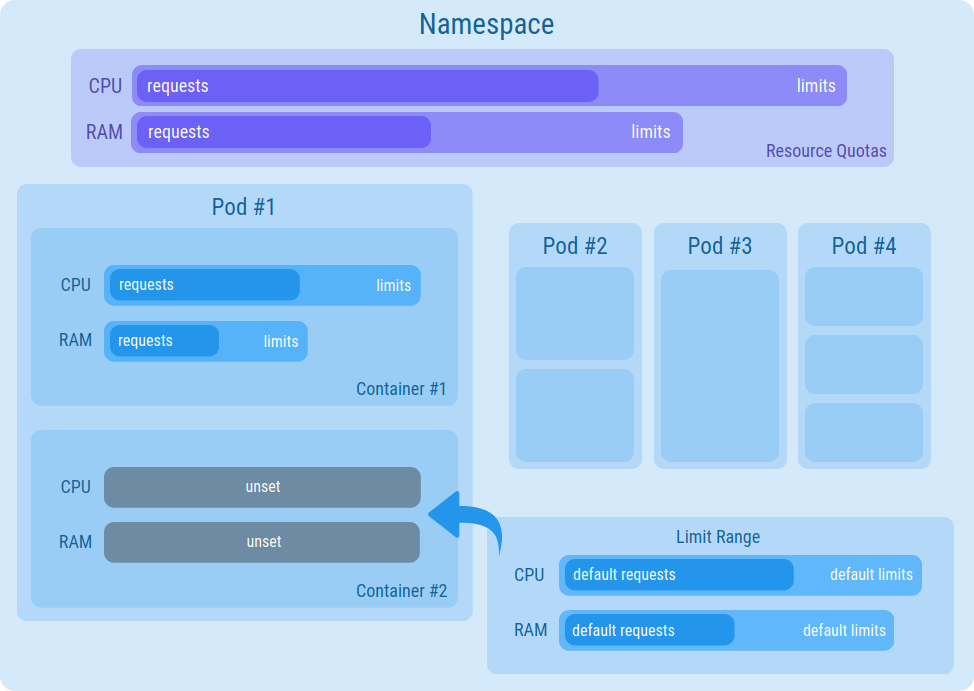Configure Limit Ranges and Resource Quotas
Background
What are Limit Ranges?
Limit Ranges are Kubernetes objects defined at namespace level, that can be leveraged to simplify resource control over Containers and Pods.
Besides restricting resource allocation, they provide the possibility to define default values for CPU/Memory requests and limits, to be applied to all the Containers whose resources field was left undefined.
Click here to read the official documentation about Limit Ranges.
What are Resource Quotas?
Resource Quotas are a Kubernetes tool to constrain aggregate resource consumption per namespace. Their main purpose is to assign a portion of resources to each namespace, thus preventing environments from consuming more than their fair share.
Click here to read the official documentation about Resource Quotas.

How to choose ranges and quotas
When creating a new project, default configurations of both Limit Ranges and Resource Quotas are provided. The values chosen for the default objects were selected after running analysis over existing environments.
Limit Ranges
apiVersion: v1
kind: LimitRange
metadata:
name: default-limit-range
spec:
limits:
- default:
memory: 300Mi
cpu: 300m
defaultRequest:
memory: 150Mi
cpu: 100m
type: Container
The snippet above shows the default LimitRange configuration. Requests and limits are slightly above the average resources needed by Containers in our environments, thus they should be enough for any new Container.
Nevertheless, they may happen to be significantly higher than the resources needed by your services, and you may end up wasting resources.
Thus, it is highly recommended to define proper requests and limits for each Container included in every Pod and tune your LimitRange accordingly.
You can follow this tutorial on how to set requests and limits of a microservice, and leverage the results to find more suitable defaults for your custom LimitRange.
Resource Quotas
apiVersion: v1
kind: ResourceQuota
metadata:
name: default-resource-quota
spec:
hard:
requests:
cpu: "1"
memory: 1Gi
limits:
cpu: "3"
memory: 2Gi
The default ResourceQuota configuration file is illustrated above. Although they are still the result of analysis over existing environments, in this case the default values are very strict and may not be suitable for your namespace.
The reason behind this choice is to encourage tuning the values according to the environment needs.
Not setting the ResourceQuota specs to proper values may lead to errors and slowdowns. Use the defaults at your own risk!
There are no best practices on how to tune Resource Quotas. There may be multiple suitable policies for a project, depending on how many resources were assigned to the project, how many and which environments it requires, and so on.
An example1 may be a project that was assigned 32GiB RAM and 16 cores of a multitenant cluster. Let's say this project needs 3 environments: development, preproduction, and production. A possible policy would be:
- 18GiB RAM and 8 cores for the production environment, to constrain it as little as possible;
- 10GiB RAM and 4 cores for the preproduction environment;
- 2GiB RAM and 2 cores for the development environment (assuming it is just for testing purposes);
- 2GiB RAM and 2 cores in reserve for future allocation.
As shown in the example above, it is highly recommended to define different quotas depending on the environment. This way, you can ensure proper distribution of resources among all the namespaces of the project, while avoiding provisioning issues.
For the time being, to edit your LimitRange and ResourceQuota, you will need to access the files in the Configurations repository of your project.
The defaults are located in each environment directory, inside the configurations folder.
To avoid errors, remember to tune the values BEFORE releasing the project.